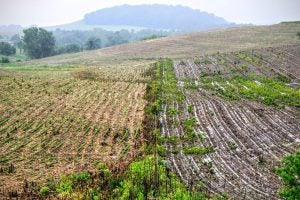Over the years, we in agriculture have seen miraculous improvements in our industry. From better livestock and crop genetics, precision ag, sensors and drones, data points, hydroponics, reduced inputs, improved equipment with auto steering, GPS, even tractors that drive themselves! Technology has improved in every aspect of our lives, and farming is no exception.
Despite the fact that we are in a fast-paced, tech-savvy industry, people in general still seem to have a romantic image of farming. They want to envision beauty — the red barns, the families, the beautiful scenery, amber waves of grain. The good news is we can have both — technology just allows us to keep the lands more pristine than in generations past.
What I’m talking about is conservation. Yes, it is true that feeding our growing population has never and will never be perfect, but farmers today can combine their love of the land with technology to do our jobs more efficiently, while improving water quality issues, reducing erosion, and improving soil health.
On our family farm, we have earned “farmers of the year” awards for our region in soil and water conservation — recognition that we are very proud of. This may come as a shock to some folks as they learn we grow some genetically engineered (GMO) grains on our farm. But the reason why over 95 percent of farmers have adopted these seed genetics is so we can use less fuel, less tillage, less pesticides, etc.
One of the benefits of Roundup-ready technology is that we can spray right over the fields without ever having to till it. We have been no-till on parts of our farm for 20 years. This helps sequester carbon, substantially reduces erosion, keeps vital nutrients and minerals in the soil, improves biological matter and soil fertility, and improves infiltration, which allows the rainwater to penetrate the roots better, thus allowing plants to thrive while improving yields.
Another part of healthy soils is using cover crops. There is a popular myth out there that only organic farmers are focused on biodiversity and natural means of soil health, but this couldn’t be further from the truth. Cover crops put important nutrients and organic matter back in the soil. They can suppress weeds, reduce soil erosion and runoff, and keep your soil covered and compacted during the harsh winter months. There are many similarities between organic and modern conventional farming methods; any farmer can practice this regardless of marketing label.
A couple of other conservation practices we adhere to are crop rotation, soil testing, and IPM (integrated pest management). While farmers make up less than 2 percent of the population of North America but are required to feed the masses, environmental stewardship means they must be very careful to not over-use chemicals or fertilizers. This is where all these other conservation methods come into play — and also help the farmers’ bottom line. Crop rotation … say, between corn one year and soybeans the next, means these plants are returning important nutrients back into the soil. Soy is a legume, while corn is a grass, and the root systems and nutrient needs are different, therefore they make a great team. Farmers in the South might rotate cotton and peanuts for similar reasons, as another example. This reduces the need for chemicals and fertilizers.
Soil is living. If you don’t have good soil, you can’t have good yields. This is why farmers work with experts to make proper decisions as to how they can improve this. Soil tests tell them exactly how healthy their soils are and exactly how much fertilizer they need to apply. Years ago farmers didn’t have this and would just apply fertilizers the old fashion way, but now with modern soil tests farmers can save money while using less fertilizer, which ultimately helps the planet and the their wallet.
Sometimes farmers are “set in their ways” of being old-fashioned and really like to see and smell that fresh tilled black dirt. But if you look at the improvements of soil and water health, not only does it help the planet, but it also helps their finances. It is true that tillage can increase soil temperature, but overall modern conservation offers huge advantages. Just look at what Farmer Dennis has to say!

When soil is heavily tilled, you can sometimes witness it blow away on a dry, windy day. You can also see the rainwater sit on the top of the soil here, rather than infiltrate the soil and root system like you might through no till, cover crops, and rotated-crop residue.

My boyfriend’s brother is a soil scientist and you can watch our fun video #SoilYourUndies here, which shows improved biological activity through undisturbed soil. For more information about modern farming conservation programs, visit www.nrcs.usda.gov.
Michelle Miller, the Farm Babe, is an Iowa-based farmer, public speaker and writer, who lives and works with her boyfriend on their farm which consists of row crops, beef cattle, and sheep. She believes education is key in bridging the gap between farmers and consumers.



